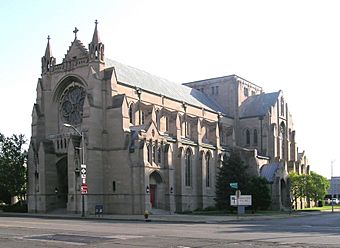Cathedral Church of St. Paul (Detroit) facts for kids
|
Cathedral Church of St. Paul Complex
|
|
 |
|
| Location | 4800 Woodward Avenue Detroit, Michigan |
|---|---|
| Built | 1907–8 |
| Architect | Ralph A. Cram |
| Architectural style | Late Gothic Revival |
| MPS | Religious Structures of Woodward Ave. TR |
| NRHP reference No. | 82002893 |
Quick facts for kids Significant dates |
|
| Added to NRHP | August 3, 1982 |
The Cathedral Church of St. Paul is a very important church in Detroit, Michigan. It is the main church for the Episcopal Diocese of Michigan. This church's group of worshippers started in 1824. It was the first Episcopal church and the first Protestant church in the Michigan Territory.
The building was designed by a famous architect named Ralph Adams Cram. It was built in 1907. You can find it at 4800 Woodward Avenue in Midtown Detroit. It is right next to Wayne State University. This beautiful church was added to the National Register of Historic Places in 1982.
Contents
History of St. Paul's Church
The St. Paul church group began in 1824. It was started by Reverend Richard Fish Cadle. This was the first Episcopal and first Protestant church group in what was then the Michigan Territory. The first St. Paul's church building was on Woodward Avenue. It was located between Congress and Larned streets. In 1851, the church moved to a new spot. This was at the corner of Congress and Shelby streets.
A very famous event happened at the Cathedral Church of St. Paul. The funeral for Henry Ford was held here on April 10, 1947. Henry Ford was an entrepreneur who helped create the car industry in Detroit. Many people wanted to say goodbye to him. The day before the funeral, thousands of people visited his viewing. At the funeral service, about 600 people were inside the church. An amazing 20,000 people stood outside in the rain. This funeral got attention from all over the country. It is thought that seven million people were sad about his death.
Architecture and Design
The church building you see today was designed by the well-known church architect Ralph Adams Cram. It was built starting in 1907. The building is still not fully finished. For example, its bell tower was never completed. The church is made of limestone. It was built using old medieval methods. This means it does not have a steel frame inside to hold it up.
The building has tall, pointed arches. It also has large, colorful stained glass windows. The detailed stone carvings are also very special. These features are great examples of Gothic architecture. The church also has a large art piece made of Pewabic Pottery. In 1912, this building became the main cathedral for the diocese.
Why This Building Is Important
St. Paul's Cathedral is a wonderful example of the Late Gothic Revival style. This type of architecture was very popular in the early 1900s. American architects in the mid-1800s brought the English Gothic Revival style to the U.S. They used ideas from the beautiful details of old Medieval cathedrals.
Later, in the early 1900s, architects like Ralph A. Cram had new ideas. They believed that Gothic architecture should grow and develop. They did not think it should just copy old Medieval churches. St. Paul's Cathedral was one of Cram's first big projects. It really shows off his special "Late Gothic Revival" style.
Current Activities
The main leader of the cathedral today is the Very Reverend S. Scott Hunter. He used to be a Canon for the Diocese of Michigan. The cathedral also works with the Detroit Cultural Center. They plan different programs and events together.
See also
 In Spanish: Iglesia Catedral de San Pablo para niños
In Spanish: Iglesia Catedral de San Pablo para niños

